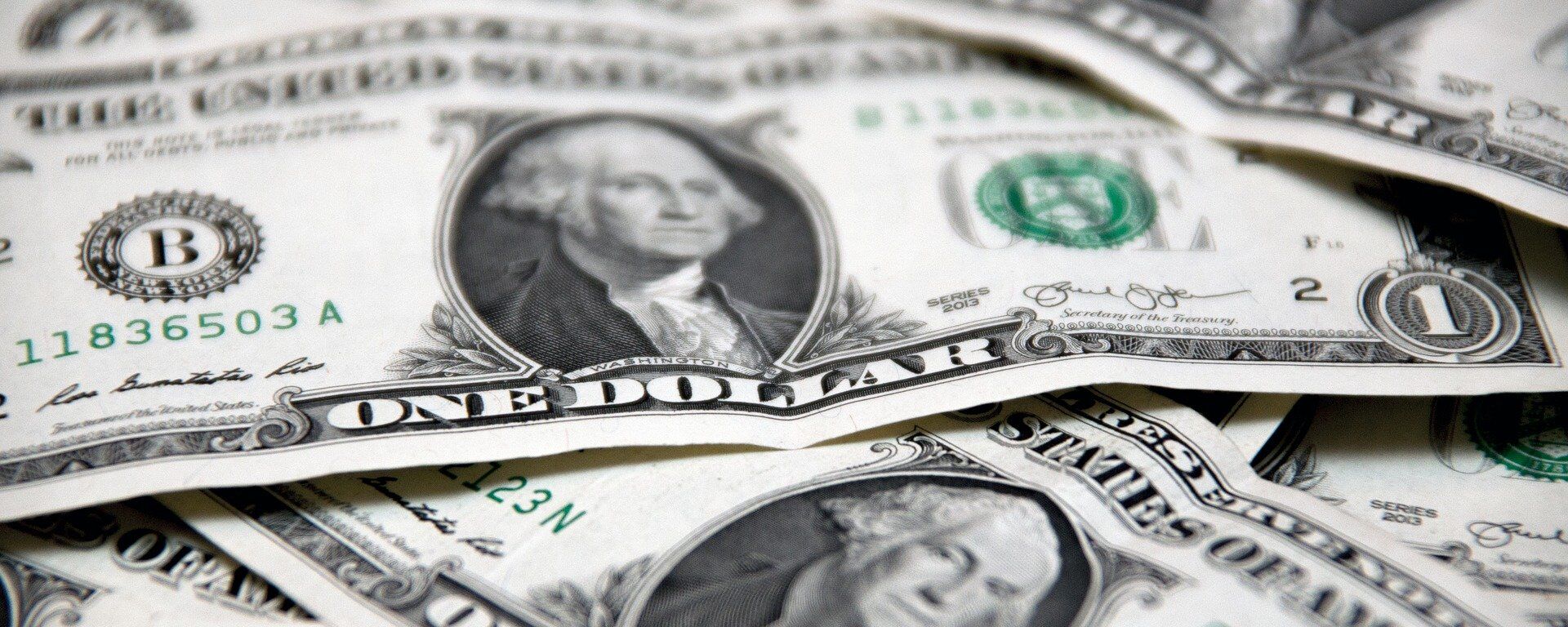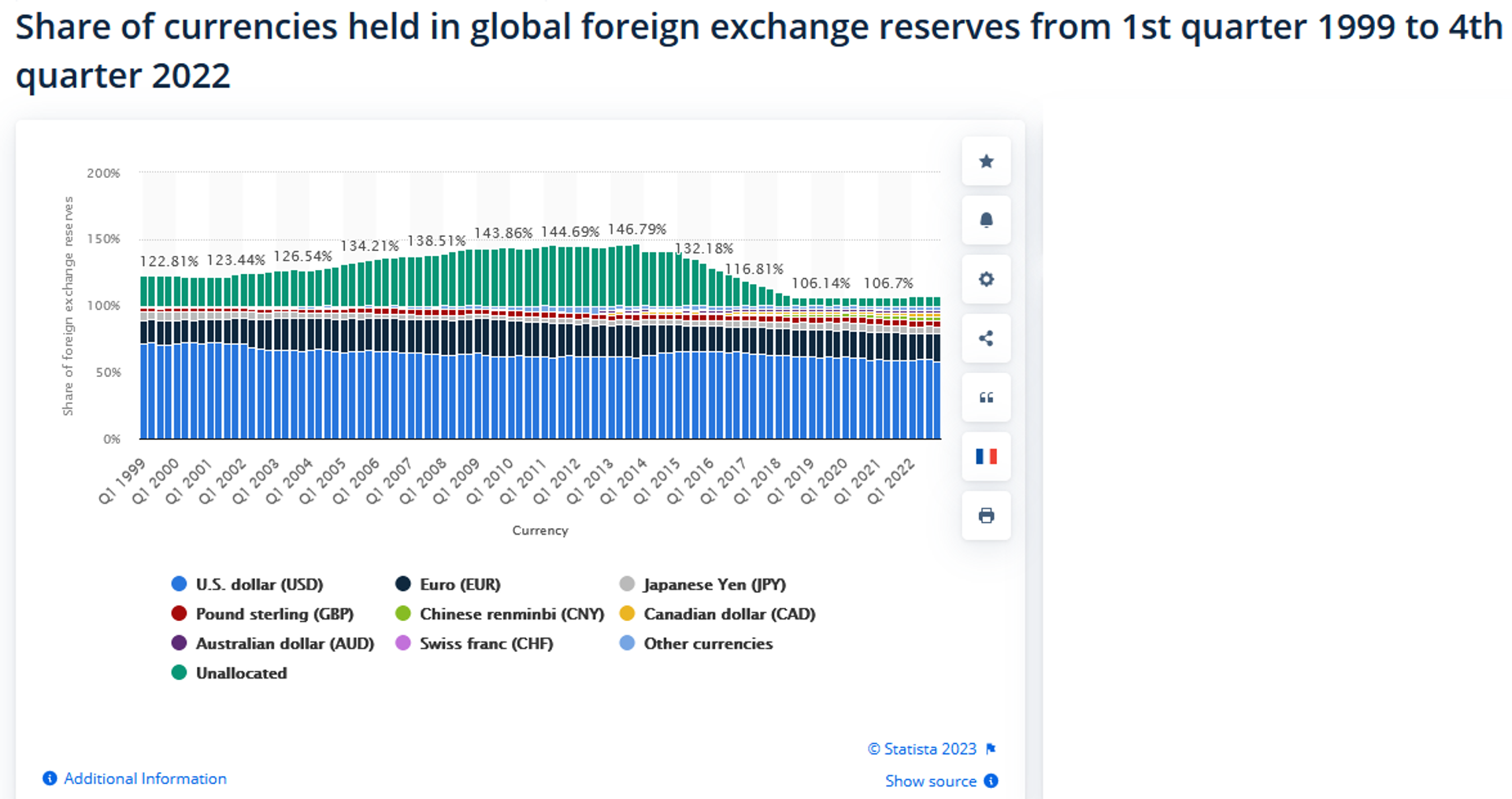https://sputnikglobe.com/20231004/dollar-hegemony-to-end-in-decade-after-being-abused-for-geopolitical-goals-1113913346.html
Dollar Hegemony to End ‘in Decade’ After Being ‘Abused For Geopolitical Goals’
Dollar Hegemony to End ‘in Decade’ After Being ‘Abused For Geopolitical Goals’
Sputnik International
The US dollar will cease to be the dominant currency in the global financial system sometime in the next 10 years, believes Jeffrey Sachs, a Columbia University economist.
2023-10-04T12:25+0000
2023-10-04T12:25+0000
2023-10-04T12:25+0000
economy
us
dollar
dumping the dollar
dollar hegemony
jeffrey sachs
valdai
brics
https://cdn1.img.sputnikglobe.com/img/107034/46/1070344646_0:100:1921:1180_1920x0_80_0_0_07604d3a5ec3a143f410b64d56fe4c52.jpg
The US dollar will cease to be the dominant currency in the global financial system sometime in the next 10 years, believes Jeffrey Sachs, a Columbia University economist. According to the American economist, US dominance in the global economy is on a path of gradual decline. At the end of World War II, the United States accounted for 30 percent of world production, while this figure is now at “only 15 percent,” the economist recalled."This share will continually decline as developing countries grow faster than the US economy," he noted.According to the American economist, “central bank digital currencies will become the basis of payments.” The finance pundit laid the blame for the unstoppable trend at Washington’s door, accusing the US government of having abused the privileges that using the dollar as the currency of choice for global trade and central bank reserve holdings was endowed with.In fact, the United States, “became reliant on using the financial system for the sake of achieving geopolitical goals."Indeed, dedollarization appears to be a persisting trend that the United States will have to reckon with, whether they like it or not. And it is pretty obvious that Washington’s own intentional weaponization of its currency, through wielding of sanctions, is one of the main drivers of this economic trend.The US dollar’s slow decline accelerated in 2022, when Washington and its allies sought to “cripple” Russia with sanctions amid the crisis in Ukraine. The restrictions, along with a decision to freeze a portion of Russia’s foreign reserves, prompted major non-Western countries, even including longtime traditional US allies and partners, to assess the potential dangers of staking everything on the greenback. While the punitive sanctions have “backfired” against those very same countries that resorted to them, Moscow and its partners have reacted by ramping up trade in local currencies. The ruble’s share in payments for Russian exports has topped 50 percent, and accounts for more than a third of Russia’s overall foreign trade, acting Federal Customs Service chief Ruslan Davydov revealed earlier this month.Recently, new European research confirmed that, for example, increased use of the yuan in trade between Russia and China is undermining the dominance of the US dollar. "Over the course of 2022, the share of Russia’s imports invoiced in yuan (CNY) increased by 17 percentage points," a research paper by the European Bank for Reconstruction and Development (EBRD) stated. By the end of last year, 20 percent of Russia’s imports were invoiced in yuan. Furthermore, the use of yuan to settle imports from third countries also surged to reach five percent, the paper added.Furthermore, amid the increased “weaponization” of the greenback by the US, at the recent BRICS summit in Johannesburg members voiced their determination to increase use of local currencies in trade and financial transactions, both between BRICS members and with their partners.With the addition of six new regional powerhouse economies from Latin America, Africa, and the Middle East to the original five-nation BRICS bloc - Brazil, Russia, India, China and South Africa - the grouping of major non-Western world economies now accounts for some 37 percent of global GDP, compared with about 30 percent for the G7.
https://sputnikglobe.com/20230914/dedollarization-accelerating-within-brics-across-globe---netley-group-1113359503.html
https://sputnikglobe.com/20230924/brics-expansion-aims-to-reduce-dollars-decades-long-dominance--report--1113632501.html
https://sputnikglobe.com/20230924/brics-expansion-aims-to-reduce-dollars-decades-long-dominance--report--1113632501.html
valdai
Sputnik International
feedback@sputniknews.com
+74956456601
MIA „Rosiya Segodnya“
2023
News
en_EN
Sputnik International
feedback@sputniknews.com
+74956456601
MIA „Rosiya Segodnya“
Sputnik International
feedback@sputniknews.com
+74956456601
MIA „Rosiya Segodnya“
dedollarization, dollar, dedollarization, ruble, russia, united states, currency, trade, reserves, finance, reserve currency, imports, exportsб brics,
dedollarization, dollar, dedollarization, ruble, russia, united states, currency, trade, reserves, finance, reserve currency, imports, exportsб brics,
Dollar Hegemony to End ‘in Decade’ After Being ‘Abused For Geopolitical Goals’
The US dollar’s share in global foreign exchange reserves has slowly declined for decades. However, amid its increasingly frequent use as a “coercion weapon” on a state level, the dedollarization trend has been gaining momentum, with US restrictions serving to ignite greater trade in local currencies between Moscow and major non-Western countries.
The
US dollar will cease to be the dominant currency in the global financial system sometime in the next 10 years, believes
Jeffrey Sachs, a Columbia University economist.
"The epoch of the international financial system dominated by the dollar is drawing to an end, and this will happen in the next decade,” he emphasized at a meeting of the Valdai Discussion Club.
According to the American economist, US dominance in the global economy is on a path of gradual decline. At the end of World War II, the United States accounted for 30 percent of world production, while this figure is now at “only 15 percent,” the economist recalled.
"This share will continually decline as developing countries grow faster than the US economy," he noted.

14 September 2023, 04:01 GMT
According to the American economist, “central bank digital currencies will become the basis of payments.” The finance pundit laid the blame for the unstoppable trend at Washington’s door, accusing the US government of having abused the privileges that using the dollar as the currency of choice for global trade and central bank reserve holdings was endowed with.
“One of the privileges was the ability to borrow at reduced interest rates. It also maintained a fairly efficient system of international payments, but the United States abused this system, especially in the last 15 years,” Jeffrey Sachs explained.
In fact, the United States, “became reliant on using the financial system for the sake of achieving geopolitical goals."
The 20th annual meeting of the Valdai International Discussion Club is taking place on October 2-5 in Sochi. Its theme is “Fair Multipolarity: How to Ensure Security and Development for Everyone.” The meeting has drawn over 140 experts, politicians and diplomats from 42 countries throughout Eurasia, Africa, as well as North and South America.

24 September 2023, 15:12 GMT
Indeed,
dedollarization appears to be a persisting trend that the United States will have to reckon with, whether they like it or not. And it is pretty obvious that Washington’s own intentional weaponization of its currency, through wielding of sanctions, is one of the main drivers of this economic trend.
The US dollar’s slow decline accelerated in 2022, when Washington and its allies sought to “cripple” Russia with
sanctions amid the crisis in Ukraine. The restrictions, along with a decision to freeze a portion of Russia’s foreign reserves, prompted major non-Western countries, even
including longtime traditional US allies and partners, to assess the potential dangers of staking everything on the greenback. While the punitive sanctions have “backfired” against those very same countries that resorted to them, Moscow and its partners have reacted by ramping up
trade in local currencies. The
ruble’s share in payments for Russian exports has topped
50 percent, and accounts for more than a third of Russia’s overall foreign trade, acting Federal Customs Service chief Ruslan Davydov revealed earlier this month.
Recently, new European research confirmed that, for example, increased use of the
yuan in trade between Russia and China is undermining the
dominance of the US dollar.
"
Over the course of 2022, the share of Russia’s imports invoiced in yuan (CNY) increased by 17 percentage points," a
research paper by the European Bank for Reconstruction and Development (EBRD) stated. By the end of last year,
20 percent of Russia’s imports were invoiced in yuan. Furthermore, the use of yuan to settle imports from third countries also surged to reach
five percent, the paper added.
Furthermore, amid the increased “weaponization” of the greenback by the US, at the recent
BRICS summit in Johannesburg members voiced their determination to increase use of local currencies in trade and financial transactions, both between BRICS members and with their partners.
With the addition of six new regional powerhouse economies from Latin America, Africa, and the Middle East to the original five-nation BRICS bloc - Brazil, Russia, India, China and South Africa - the grouping of major non-Western world economies now accounts for some
37 percent of global GDP, compared with about 30 percent for the G7.

24 September 2023, 15:12 GMT







